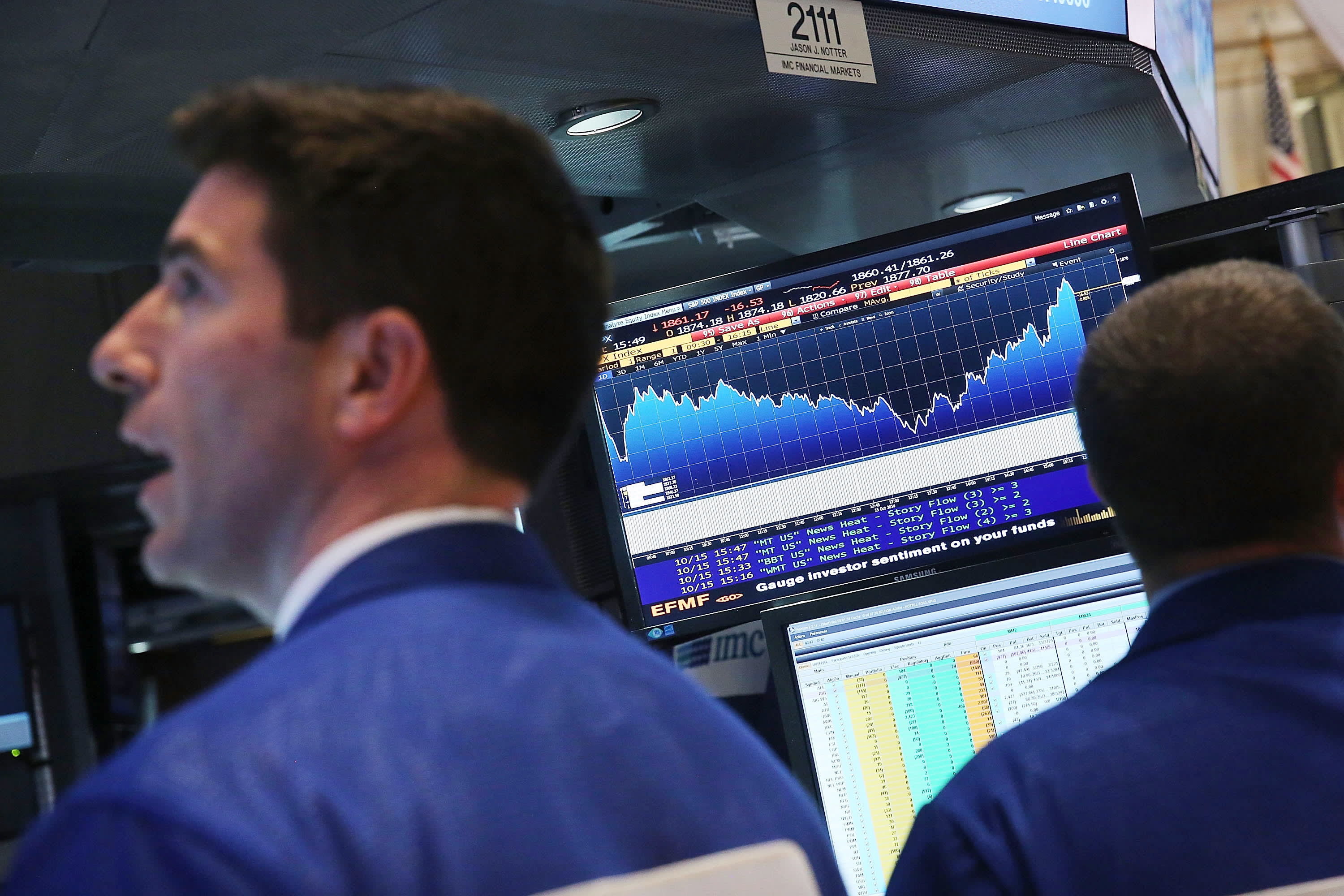As fears from Ebola and a global slowdown spread, stocks plunged on October 15, with the Dow falling more than 400 points during the afternoon before recovering slightly.
Getty Images
The market could see a pop this week after last week’s steep sell-off, based on simple historical analysis.
Though the coronavirus remains a developing health threat and so this time could be different, several studies show that quick market corrections like the one that occurred last week tend to lead to sharp gains in the weeks thereafter.
Analysis of prior market declines of 10% or more over five trading days since 1990 shows that equities tend to rebound in the weeks to follow, according to data provided by hedge-fund tool Kensho. In fact, barring an October 2008 plunge of 14.6%, every such sell-off has led to positive returns just two weeks after the fall.
Predictably, the gains tend to widen as more time after the five-day plunge passes.
For example, in the wake of the 9/11 attacks the S&P 500 then gained 10.9% over the next two weeks, according to data provided by hedge-fund tool Kensho. Those gains ballooned to 12.3% one month after the sell-off and 19% after three months. The Kensho data excludes multiple declines of more than 10% for one month after the initial slide in an effort to isolate separate bouts of market turbulence.
“The silver lining to intense sell-offs is that by the time it feels panicky, it’s generally closer to the rebound,” Jefferies Chief Financial Economist Ward McCarthy wrote Saturday. “While there are many market prognosticators that will tell you why buying a dip might not work, and why every time is different, it is hard to argue with human nature and history.”
Jefferies research into market corrections also revealed that rapid sell-off tend to lead to quick bounces.
McCarthy said that the firm’s studies of significant (three standard deviations) and quick moves in the S&P 500 repeatedly showed positive returns in the months thereafter.
“While we found that the bounces tend to be swift and robust, more importantly, performance tends to be overwhelmingly positive over a [three-month] horizon,” he wrote.
Barring the sell-offs associated with the great financial crisis, “S&P 500 performance was positive over 90% over the time, in both 1-day and 5-day scenarios,” he added. “And to be clear, as bad as Dec ’18 felt, Feb was nearly as bad … and we got there much more quickly.”
The Dow Jones Industrial Average, S&P 500 and Nasdaq Composite all fell more than 10% last week, with stocks posting their biggest weekly declines since October 2008 and the financial crisis. That slide sent the major averages firmly into correction, down more than 10% from all-time highs set earlier in February.
McCarthy, like many others, noted that much of last week’s selling appeared to stem from market fears about the coronavirus’s spread to the U.S. and its potential to disrupt economic production. The World Health Organization has confirmed that more than 87,000 people have contracted the disease worldwide and that nearly 3,000 people have died as a result.
The U.S. confirmed its first death in Washington state over the weekend while New York state and officials confirmed the illness has spread to Manhattan.
Still, there remain those unwilling to call a bottom quite yet, despite what the statistics show. At last glance, the Dow was up 100 points 30 minutes after the open Monday.
Strategists at J.P. Morgan, Citi and Goldman Sachs said over the weekend that there hasn’t been enough pain in the market yet to warrant relief.
“While ‘buy the dip’ has been a successful strategy since the Global Financial Crisis, with equity drawdowns often reversing quickly, it might be more risky this time,” Christian Mueller-Glissmann, equity strategist at Goldman Sachs, said in a note. “With global growth still weak, the shock from the coronavirus outbreak lingering and less scope for monetary and fiscal easing, the risk of a more prolonged drawdown remains.”
Citi’s Chief U.S. Equity Strategist Tobias Levkovich echoed that sentiment, saying he’d like to see even more panic before stepping up.
Subscribe to CNBC PRO for exclusive insights and analysis, and live business day programming from around the world.
